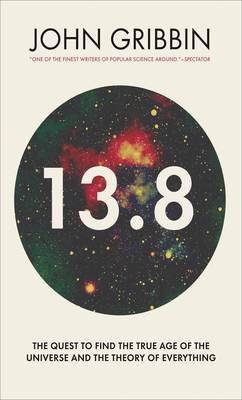
13.8
The Quest to Find the True Age of the Universe and the Theory of Everything
کتاب های مرتبط
- اطلاعات
- نقد و بررسی
- دیدگاه کاربران
نقد و بررسی

Starred review from January 25, 2016
Acclaimed science writer Gribbin (Einstein’s Masterwork), a visiting fellow in astronomy at the University of Sussex, delivers a lively and accessible look at how astronomers determined the age of our universe. Popular science titles tend to cover the same ground from similar perspectives, but Gribbin takes a fresh angle by working from two different directions: the physics of the very small (quantum theory) and the physics of the very large (Einstein’s general relativity). The development of quantum theory in the early 20th century provided the tools to work out how stars produce energy, how they evolve, and how to calculate how old they are. Then, switching tracks, Gribbin shows how determining stellar distances led to the realization that our universe is expanding. Einstein’s general theory of relativity let scientists give shape to the universe and determine both how it evolved and its age. Along the way, Gribbin intrigues with background details on such figures as the ground-breaking women astronomers Henrietta Swan Leavitt and Cecilia Payne, crack Mt. Wilson observer Milton Humason, and cosmologist Thomas Gold, who found cosmic inspiration in a horror film. Readers who are weary of typical pop science books will find themselves highly entertained.

January 15, 2016
Astrophysicist Gribbin (Erwin Schrodinger and the Quantum Revolution, 2013, etc.) clearly explains how the accidental discovery of "the cosmic microwave background radiation" in the mid-1960s led to the assignment of a definitive date for the origin of the universe. Despite the fact that physicists have yet to unify quantum physics and relativity into one coherent theory, the author believes that the implications stemming from the discovery that the universe is 13.8 billion years old definitively proves the fundamental correctness of both. "The age of the Universe calculated by cosmologists...is just a tiny bit older than the age of the stars it contains," writes the author. The most profound of these is that our universe is not unchangeably "infinite in time and space." In the 1950s, astrophysicists were divided between those who believed in a steady-state universe (led by Albert Einstein) and proponents of the rival Big Bang theory. One way of resolving the dispute was to accurately determine the densities of galaxies in space. This allowed an inference to be drawn about their development over time. The placement of radio telescopes on satellites, which used photographic plates to build up images of the universe, made this possible. Analysis of the data lent credibility to the Big Bang theory, but it was the chance discovery of pervasive cosmic microwave radiation that decisively tipped the balance in its favor. The 1980s discovery of the existence of dark matter and energy (which exert a gravitational force but are impervious to radiation) has allowed scientists to recalculate the rate of expansion of the universe more precisely to fit the observed data. In order to bring lay readers up to speed, Gribbin first reprises the crucial developments, beginning in the 19th century, that have led scientists to their current understanding. An exciting chronicle of a monumental scientific accomplishment by a scientist who participated in the measuring of the age of the universe.
COPYRIGHT(2016) Kirkus Reviews, ALL RIGHTS RESERVED.

























دیدگاه کاربران